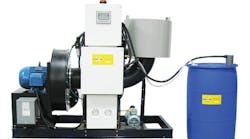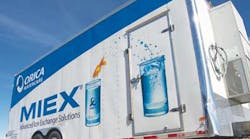Dec. 29, 2000—A collaborative effort by the Institute for Research in Construction, in conjunction with 10 municipalities and two consulting companies, has produced a new approach to condition assessment and rehabilitation of large sewers (more than 900 mm in diameter) and access holes that will help municipalities better manage their assets.
The effort is discussed in a new report from the Institute for Research in Construction (IRC), available in its newsletter, "Construction Innovation."
Large sewer structures require special attention since they are usually buried deep; without any redundancy in the system, which means that the consequences of failure in the event of collapse can be great.
The IRC assessment approach, which is applicable to both flexible and rigid pipes, is systematic and looks beyond the identification and coding of defects to the condition of the structure, its importance to the system and the requirements for its rehabilitation. The unified coding and assessment system will enable municipalities across the country to share information.
The first step in the process is to compile an inventory database of all pipes. Next, an impact assessment for both pipes and access holes is carried out. Since not all pipe segments have the same probability or consequence of failure, an impact rating system was created. This involves considering factors such as location, type of soil in which the pipe is embedded, pipe size, burial depth, sewer function and seismic zone.
Each factor is evaluated, rated and combined in a weighted formula to give an overall impact rating for a segment of pipe. The ratings for all pipe segments can be placed on a map of the sewer system for easy identification of "hot spots."
From the impact assessment with its impact rating, municipalities can determine which pipes or access holes are most likely to cause problems, and can then prioritize segments for inspection purposes. Inspection data are derived from various methods such as closed circuit television (CCTV), person entry, in-situ strength testing, joint testing, rotary sonic device, or diver. In the course of the inspection, defects are found, identified and coded.
The IRC approach provides definitions for identifying and rating defects on the basis of type and degree of severity.
There are two main types of defect—service (i.e., grease build-up, roots, infiltration) and structural (i.e., fractures, open joints and broken pipes) —and up to three levels of severity. For structural defects, factors such as the length and depth of the defect are weighted to give a structural rating; in the case of service defects, factors such as the percentage of the cross-section that remains open govern the service rating of a pipe segment.
The condition assessment, comprised of the impact rating, the structural rating and the service rating, is the basis for making decisions about the approach to rehabilitation - do it now, do it within the next five years, or leave it alone.
Once the decisions on rehabilitation and on the required frequency of inspection have been made, the pipe or access hole is "returned to the database" until its next scheduled inspection.
For more information about the guideline document on IRC's condition assessment approach, please contact Shelley McDonald at (613) 993-3816, fax (613) 954-5984, or e-mail [email protected].

